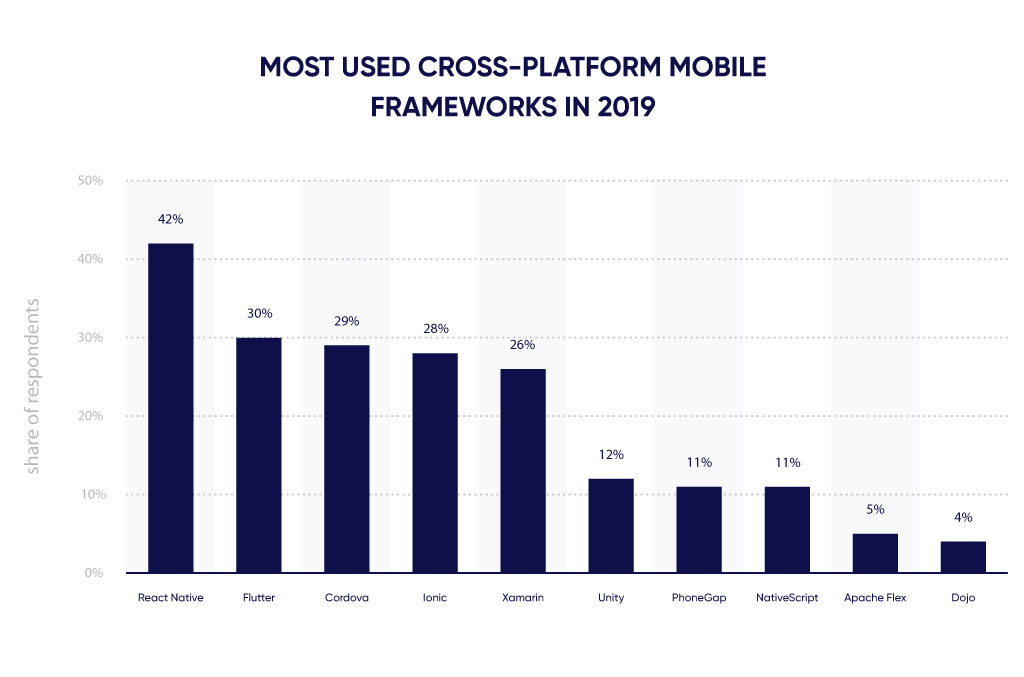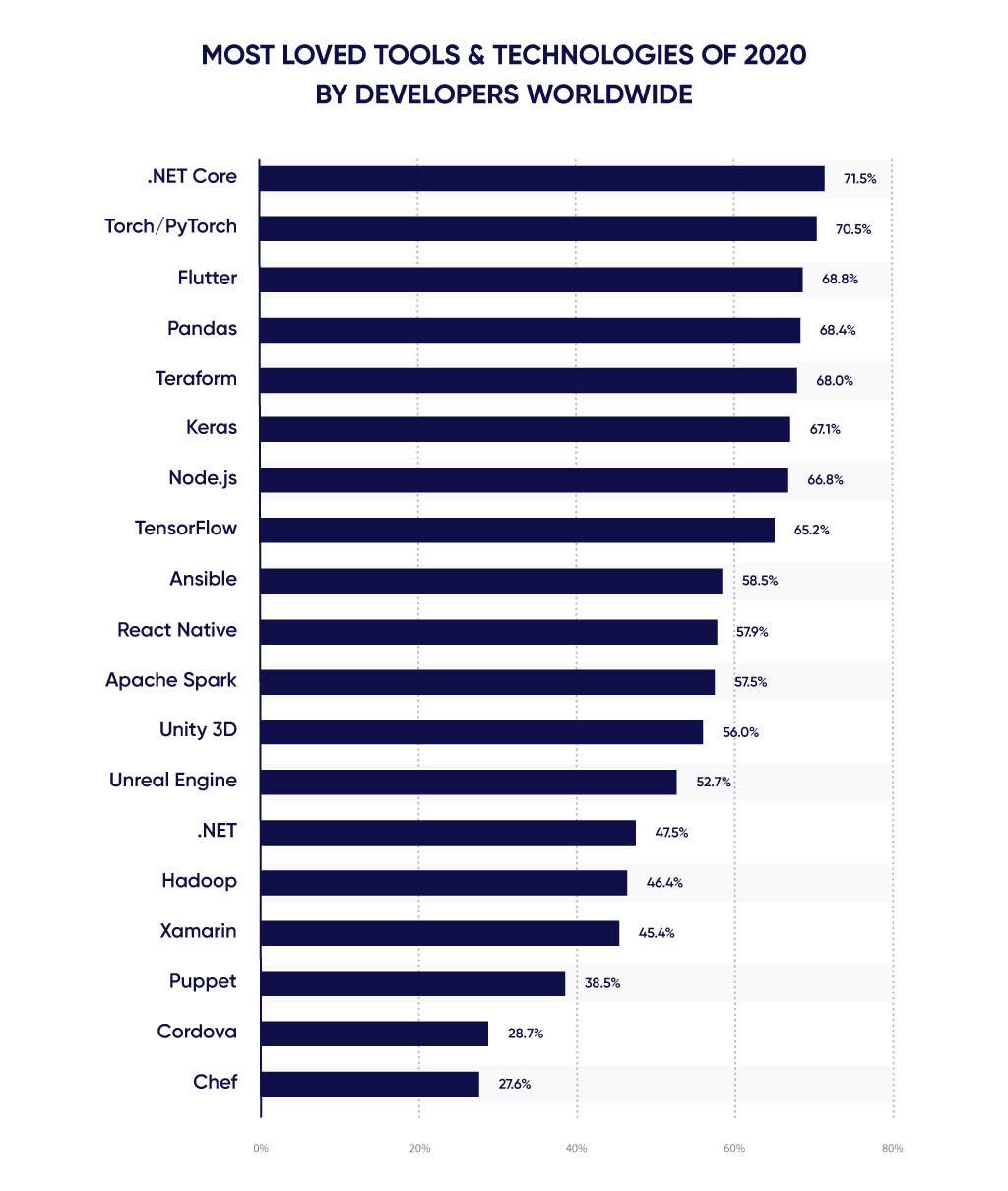Using Flutter, developers can build attractive apps in record time and cover the iOS and Android platforms simultaneously. Flutter programming takes less time and saves more money than native development, which implies that two development teams must work with two different platform-specific technologies to build separate apps for Android and iOS.
Flutter is a Google-maintained SDK that achieved a reputable position in mobile app development, and experts deservedly consider it the best cross-platform framework of today. Such companies as BMW, Square, The New York Times, etc. use it in their applications. A positive attitude towards this framework is caused by its innovations and numerous advantages.
This article will be a useful read for business owners who plan to create or improve their mobile app with Flutter and developers who want to take a career path in Flutter development. It will tell you how the usage of this framework has drastically increased in two years after the release. You’ll also learn more about the advantages that make this framework one of the most loved and wanted by businesses and developers.
Flutter Usage Statistics
The goal for the Flutter team was to present an alternative vision for the typical layout provided by similar frameworks and promote the idea of faster development cycles. At first, hardly anyone could see the purpose in releasing another cross-platform SDK because React Native was quite successful back then. Today’s figures say that over 2 million developers have tried Flutter and noticed higher flexibility and productivity compared to other toolkits.
According to Statista, Google Flutter was the second most popular technology for application development in 2019. About 7,000 people took part in this survey, and 30% of them stated high loyalty to this framework. Below, we can observe React Native taking the lead with 42%. Also, Cordova and Ionic are slightly inferior to Flutter (by 1-2%).

While other frameworks weren’t showing any significant updates, and the most pressing problems were left unsolved for long, Google released Flutter to promote a new vision on cross-platform programming. Everything starting from the layout, widget set, the Dart language to a robust rendering engine expressed a fresh look of Google to building apps. This fact caught the interest of many software development professionals throughout the world, and new apps started to appear in the market.
In February 2020, the Stack Overflow survey showed that almost 70% of 65,000 developers worldwide are highly loyal to Flutter. These figures made Flutter the third most loved development tool among all existing libraries, frameworks, and other technologies. The .NET Core framework takes the first and the second place belongs to Python’s high-level library PyTorch. Flutter also takes the lead among its direct competitors – React Native, Xamarin, and Cordova.

It took just two years for Flutter to become a frontrunner in the mobile app development market. Two main factors cause its popularity and vast appreciation:
- Google. If anyone sees that Google has something to do with a particular product or technology, developers are likely to trust it and have no doubts about its high quality.
- Innovation. The Flutter team aims to eliminate the cross-platform development issues that each developer has ever faced throughout their career.
In other words, Flutter is based on the collective opinion of mobile developers who wanted to make their work more comfortable and productive. They questioned the convenience of the traditional frameworks and created an alternative solution with a new set of instruments, different layout, and fast rendering engine. This new solution provided both development teams and businesses with a variety of benefits described below.

Flutter Advantages for Business
Flutter’s popularity has been growing faster among enterprises throughout the world. Most companies use this framework to cover iOS and Android platforms simultaneously and create distinctive brand-boosting user experiences. Other enterprises choose to add Flutter components to the existing products to enrich or improve their functionality. Besides making their initial expectations real, Flutter developers have everything to provide enterprises with more than they expect. Below, there’s the full list of the business advantages offered by the framework.
Cost-Effectiveness
Cost optimization is an essential goal for every company. Flutter helps businesses save money on development, which makes it more preferable than native solutions. When it comes to native development, business owners have to pay twice. In fact, they must share the available budget between two separate teams working with two platform-specific technologies, so make sure you have enough money. Flutter allows creating one application for several platforms simultaneously, which significantly reduces expenses on human resources and shortens the time required to complete the development tasks.
Fast Time-to-Market
When creating a native app, it’s difficult to predict whether the separate iOS and Android teams will be able to work in complete synchronization to release the product on time. Having one Flutter team that works under both iOS and Android at the same time ensures faster time-to-market. Other cross-platform solutions can also have the same advantage, but Flutter stands out from those frameworks by accelerating the process by 20% to 50%. It offers a much efficient toolkit, faster rendering engine, and the Dart language created exceptionally for cross-platform coding that contributes to faster time-to-market.
Expressive & User-Friendly UI
People enjoy aesthetic applications. You should care about making the user interface as attractive as possible to urge people to use it longer and more frequently. The framework offers a set of distinctive and eye-pleasing widgets, and developers have no problems working with them. The Flutter team continuously improves the libraries containing various interface components to make apps even more attractive and responds fast to the dev community questions and ideas on enhancing the widget system.
Native Feel and Performance
With the Skia 2D graphics library, developers create fast-responsive apps with glitch-free graphics at the native speed of a mobile device. By using Dart and compiling an application ahead-of-time, a development team ensures close-to-native operational speed. Server requests, file handling, and platform API do not affect application performance.
Most applications created for business purposes don’t require complex logic or high computational speed. Mobile games are an exception here. However, it is possible to build simplistic 2D games with Flutter, if you want one. So, Flutter can be the right choice if you need a simplistic, stable, and fast application with close-to-native user experience.
Improvement of Existing Apps
A development team can add the Flutter packages or use its module template as a library in the existing codebase. In this way, the team can enrich or improve both native or non-native apps with new UI components. Essential Studio by SyncFusion is an example of the product that includes Flutter elements for managing PDF files, generating barcodes, and charting.
Benefits for Developers
As of 2020, over 2 million mobile programmers worldwide have tried Flutter and noticed its difference from other SDKs. In this part, we will describe the benefits that the framework offers to app development specialists.
Open Source Framework
Flutter is an open source product that lets developers use its instruments for free and manage problems more quickly than any proprietary software. Specialists also have enough freedom in programming and can work more productively within agile practices, when each team member must stay highly flexible to meet the client’s changing requirements.
Fast Development
Sometimes, the development process can be slow because programmers must compile the entire application every time they change it. With Flutter, a developer can save the app’s state and update it in less than a second with hot reload. Besides, a Flutter developer works with a single codebase and doesn’t require setting additional elements between the code thread and native UI like in JavaScript programming.
Any Flutter app is compiled into machine code Ahead-of-Time, which makes applications fast and highly performant, and uses graphics and visualization tools in C/C++. They can consistently produce 60 frames per second on most devices and up to 120 frames per second on Flutter-enabled devices.
Customizable Widgets
The fundamental elements of Flutter apps are widgets. Sometimes developers face problems when trying to make an app look the same for both Android and iOS operating systems because they are entirely different by design. Widgets provided by the framework helps developers avoid these problems.
Flutter includes Material Design elements that allow creating Android apps. While working on the iOS part, a specialist can use the Cupertino library integrated into the SDK. They can also draw any required elements with available Flutter capabilities, so it’s no longer necessary to look for the right design element elsewhere.
Convenient Programming Language
Most hybrid mobile frameworks rely on JavaScript, HTML, and CSS, but Flutter is an exception. JavaScript is one of the most hard-to-learn languages; however, web development can’t do without it. Flutter programming requires knowledge of Dart. This language was created by Google exceptionally for multiplatform development. The benefits of Dart are:
- absence of competing standards;
- clean syntax, no logical intricacies like in JavaScript;
- maintenance simplicity;
- no need to use any additional tools or programs;
- compatibility of all design templates, and many other advantages.
Growing Community
When using Flutter, coders notice a significant increase in performance compared to similar technologies. This is a decisive factor why many of them decide to start working with Flutter. Specialists appreciate its clear documentation and friendly developer community, which unites experts and beginners ready to share their knowledge and experience. The participants provide clear examples of their project models and development templates. It’s much easier to master the technology for the significant number of coders within a friendly community.
Conclusion
Flutter has replaced the traditional architecture of mobile applications with the simpler one. When developing this framework, Google refused from JavaScript because of the numerous intricacies and inconvenience of the language in favor of more simple Dart. The company successfully achieved this aim, which made the framework beneficial for entrepreneurs and convenient for developers. Flutter solutions save money, time, and human resources while offering almost native productivity of an app.
It seems like the world is mad about Flutter nowadays, and Google made it worthy of increased attention. If you want to get the same benefits for your applications, contact us to discuss the opportunities of this SDK and get help from professional Flutter developers.




